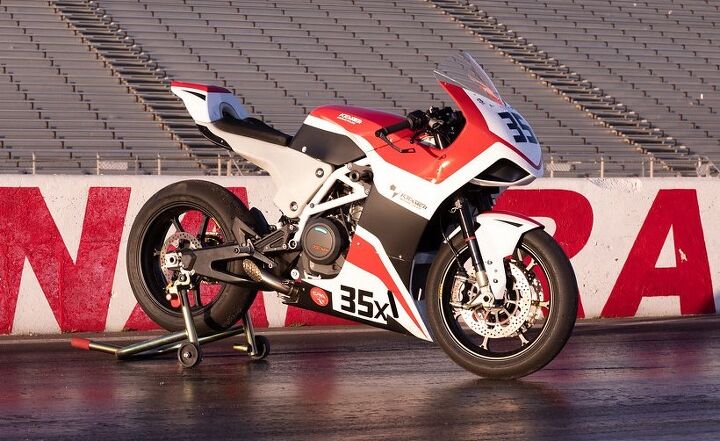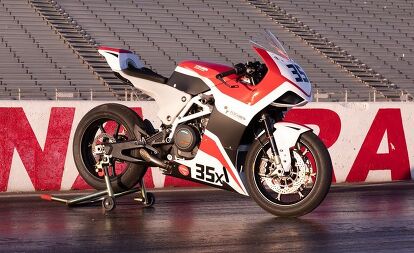Kramer HKR-EVO2 Review

The Coolest Sportbike You've Never Heard Of
Motorcycling is a niche activity, with sportbikes comprising a small niche within it. Track-only sportbikes make up such a miniscule niche within a niche within a niche that they’re almost not worth talking about. Until one so cool comes along that we’re forced to pay attention. The Kramer HKR-EVO2R is such a machine. This is its story.
In the lore of sportbike mythology, there’s one motorcycle not often spoken of, but always revered when brought up in conversation: the Ducati Supermono. An extremely rare machine, Wikipedia says only 67 units were built between 1993 and 1997. Adding to the rarity was the fact it housed a Single-cylinder engine (effectively the front cylinder of an 888 with a dummy connecting rod on the other side to help cancel out vibrations – again, thanks Wikipedia) with a desmodromic head, of course.
It was essentially a mini superbike of the time, equipped with top-shelf Öhlins suspension, Weber fuel injection, and carbon fiber everywhere. Power-to-weight was the name of the game, and those lucky few who got to ride – and win – on one only added to the bike’s mythological status. Before he was derided for designing the original Multistrada and 999 superbike, Pierre Terblanche penned the Supermono’s appearance. He designed plenty of other attractive motorcycles, too (Ducatis included), but nobody seems to remember those. Anyway, I digress.
Ever since, the thought of a lightweight, single-cylinder sportbike has appealed to many a garage tuner out there, with several examples of people yanking four-stroke dirtbike engines and stuffing them into sportbike chassis’ (old two-stroke roadracers come to mind) – or working the other way and converting 450cc motocrossers into suitable roadracers. For one reason or another, the idea never caught on en masse, despite heavy promoting from some corners of the moto world. Just ask Roland Sands how that turned out.
The Kramer Story
Undeterred by past attempts to revive the supermono, Markus Kramer set about to produce his rendition of the ultimate single-cylinder road racer. This time Kramer eyed the Single inside the KTM 690 Duke. A logical choice for a number of reasons: streetable reliability and respectable power being two big ones. But the biggest reason this was a logical choice is Kramer’s own personal ties to the engine – he used to be on the KTM payroll.
Designing or building the 690 engine wasn’t one of his responsibilities, but being inside the building everyday – even weekends – made him acutely aware of what it could do, and naturally, he made some deep connections with those in the engine and chassis departments. These connections ran so high up the chain of command that when Kramer decided to leave the company and pursue his dream of building his own track-focused race bikes, Hubert Trunkenpoltz (the T in KTM) agreed to sell him engines – something KTM hasn’t done for anyone else.
The long, winding road to get to the HKR-EVO2 involves lots of testing with 690 engines inside RC8 frames (EVO1) and Kramer’s chassis engineer friends helping him fine tune the package. I won’t bore you any further with the details because I’ve told the Kramer Motorcycles story before, but I still find this background information so interesting.
The HKR-EVO2R
Going back to the Supermono ethos at the top of the page, while the HKR-EVO2R may not have any Ducati DNA, it’s undoubtedly the modern day successor. A completely standard 690 Duke Single sits inside a bespoke Chromoly steel trellis frame – not a repurposed KTM piece. Same goes for the swingarm. The engine is said to make 80 horses at the crank, equating to about 70 or so to the wheel. Better yet, it’s only pushing 275 pounds (with about half a tank of gas).
How Kramer achieves such low weight numbers is part of the appeal of the bike, at least to me. The front subframe is rotomolded, wheels are Dymag forged aluminum, brakes are top-shelf (and lightweight) Brembo Stylemas, and unlike a road-legal motorcycle, there’s no unnecessary fluff like lights or emissions equipment. A Kramer is pared down to the essentials needed to go fast.
But, the pièce de résistance is undoubtedly the one-piece XPE plastic rear subframe that doubles as the seat and 3.17-gallon fuel tank. Available in either black or clear, the latter lets the rider instantly see just how much fuel they have. Moving fuel to the seat lowers the center of gravity and opens the area usually reserved for a gas tank to serve as the airbox for the 690. There’s also space under there to house a tiny lithium battery, and some other ancillary bits. Lastly, the tank’s lower mount is eccentric, allowing its position to be changed up or down depending on rider preference.
Having an in at KTM goes beyond engine support. As KTM also owns WP suspension products, you also see Kramer motorcycles sporting WP forks and shocks, too. They’re fully adjustable and sprung for riders in the 170-pound ballpark. The thinking goes, I assume, that anyone weighing substantially more probably isn’t looking at one of these anyway. If you are, springs and valving are simple to change (for a fee). Same goes for light folks, too.
Ready To Race
If you’ve read my reviews in the past then you know I’m a performance-minded kind of guy. The science and engineering of speed and quickness compels me, and exploiting that engineering excites me. Road-legal motorcycles, even sportbikes, are inherently full of compromises. They need to be. But that’s also why the aftermarket exists. With that in mind it’s all the more impressive how good your standard motorcycle is right off the showroom floor.
What happens, then, when you hop on something not hindered by pesky things like government regulations? Something built for a single task? What happens is the discovery of what it means to be razor-focused. Everything is precise. Every input leads to an action. Confidence and communication go hand-in-hand. The chassis tells you exactly what’s going on underneath you no matter your lean angle, and the message is usually “I’ve got you. Go faster next time.” Those rare times it’s not, it tells you that, too. When you combine this combination of precision, communication, and lightness, you can put the EVO2 exactly where you want it, lap after lap.
Horsepower is a hypnotizing phenomena, especially in racing. It seems as though the more of it you have, the more you want. I’d be lying if I said I’m not a fan of horsepower also, but when you’ve only got about 70 of them making their way to the rear tire, you’re forced to focus on riding technique and race craft to make a quick lap. Instead of relying on power to mask your deficiencies, you’re constantly pursuing the perfect line, opening the throttle sooner, or using the brakes later to exploit the Kramer’s strengths instead of exposing its weakness. In short, riding a Kramer forces you to perfect your technique. When you get it right, there’s no better feeling on two wheels. It’s this pursuit of perfection that appeals to me more than power.
Of course, chasing perfection requires a cohesion between all of a motorcycle’s components. Since the EVO2 is built around a Single, it’s inherently narrow, but its clip-on bars are placed wide to give you plenty of leverage. Not that its forged wheels require much effort to change direction. When it comes time to slow down, which is rare, a pair of 290mm discs are clamped by Brembo Stylema calipers, fed through a Brembo master. Track nuts might be surprised at the choice of 290mm discs, but the bike doesn’t weigh very much and, in the grand scheme of things, is probably only hitting 130 mph on the longest of straights. Point being, there’s plenty of firm, responsive stopping power to slow down.
If there is an area worthy of criticism, it’s the suspension. For glass-smooth surfaces like you often find at European tracks, there’s not much issue. But at many of America’s bumpy tracks you’ll reach the limits of the shock’s adjustment range quickly if you’re pushing hard. Then again, I’ve heard of riders heavier than 170 pounds knocking on the door of lap records with the standard components. Your mileage may vary in this case, especially depending on your riding style. Nonetheless, this inconsistency is not something you typically find with a certain Swedish company…
Support
The unfortunate truth in racing is crashing, and a natural question on many people’s minds is what level of support do you have with a small company like Kramer when the inevitable happens. I’m ashamed to tell you that I know from firsthand experience just how well Kramers crash. Mine was a simple lowside, but I’ve also witnessed first-hand Kramers toppling end-over-end. In both cases the bikes suffered a bent clip-on. The tumbling Kramer suffered a lot more cosmetic damage, but functionally the only other thing replaced was a frame slider.
These bikes crash remarkably well, and commonly used spare parts like clip-ons, pegs, and frame sliders are a phone call away to Kramer USA in Fargo, North Dakota; which, really, is just one guy – Joe Karvonen. But even if you don’t need to replace damaged parts and are just looking for tips, tricks, or advice on working on the bike, Joe is a wealth of information. It’s understandable to be cautious when dealing with any small company, Kramer included, but in so much as you can be comfortable buying a niche machine, the after-purchase support from Kramer is top-notch.
The Supermono Lives On
By now, after sorting through the components, looking at the pictures here, reading about what it’s like to ride, and getting a slice of the ownership experience, you likely get the idea that this is one serious bit of kit, wholly inspired by the Ducati Supermono of long ago, but on a scale more reachable. And when I say reachable, I mean in terms of production and actually being able to get one. Of course, therein lies the rub. “Getting one” will set you back $22,495. No matter how you slice it, that’s steep. If you’re just looking to get into middleweight twins racing on the cheap, you can grab a used SV650 or FZ/MT-07 for a fraction of the cost and be on your way.
Comparing new versus used isn’t entirely a fair comparison though, so let’s break things down a little further. When you factor in how much would it cost to buy a new 600, or even a 650 Twin, then all the components needed to make it a front-running, competitive machine, you can easily surpass the price of an EVO2 – and that assumes you’re doing all the work yourself. Also, too, assuming you’ve chosen to race a 600, you’re now racing in what many people call the meat-grinder class, where today’s up-and-comers (and potentially tomorrow’s stars) are working to make a name for themselves. The competition is cutthroat and aggressive, and unless you’re willing to lay it all on the line you’ll likely be mid-pack, at best.
With the EVO2R, your lump sum of cash gets a fully-prepped machine, ready to win races. No additional leg work needed. All you have to do is gas it up and ride. It’s extremely competitive anywhere middleweight twins like the Suzuki SV650 or Yamaha MT-07 are raced (except MotoAmerica Twins Cup because, well, it’s not a twin), and here’s a pro tip: when it comes to rules for single-cylinder motorcycles, it’s basically the Wild Wild West across nearly all club racing organizations in the US (at least the ones I’ve looked up). You can run as mild or wild a bike you want, as long as it only has one cylinder. Whatever displacement, whatever modifications. So, instead of being mid-pack on a 600, you stand a chance of being at the front and bagging a championship or two on a Kramer. Factor in your tire bill and chances are, yet again, that you’re very likely to come out on top on a EVO2 compared to a multi-cylinder machine.
If national, or even international, fame and glory is your life’s dream in motorcycle racing, then by all means pursue that dream. For the rest of us who realize regional glory (whatever that means to you) via club racing is probably as far as we’re going to get in this sport, the Kramer HKR-EVO2R is the ticket to take you there.

Troy's been riding motorcycles and writing about them since 2006, getting his start at Rider Magazine. From there, he moved to Sport Rider Magazine before finally landing at Motorcycle.com in 2011. A lifelong gearhead who didn't fully immerse himself in motorcycles until his teenage years, Troy's interests have always been in technology, performance, and going fast. Naturally, racing was the perfect avenue to combine all three. Troy has been racing nearly as long as he's been riding and has competed at the AMA national level. He's also won multiple club races throughout the country, culminating in a Utah Sport Bike Association championship in 2011. He has been invited as a guest instructor for the Yamaha Champions Riding School, and when he's not out riding, he's either wrenching on bikes or watching MotoGP.
More by Troy Siahaan



















































































































Comments
Join the conversation
End of last season was talking with Kayla Yaakov, she was suppose to be on a Kramer this year. She is an amazing rider and a great kid. Hate this season has gotten all screwed up, I really look forward to see her ripping up the track and getting feedback on the Kramer. Hopefully we can get back on the track soon!!
As a guy with mass closer to Pedrosa's than to Petrucci's, I wish suspension setup were included in the purchase price of new bikes.